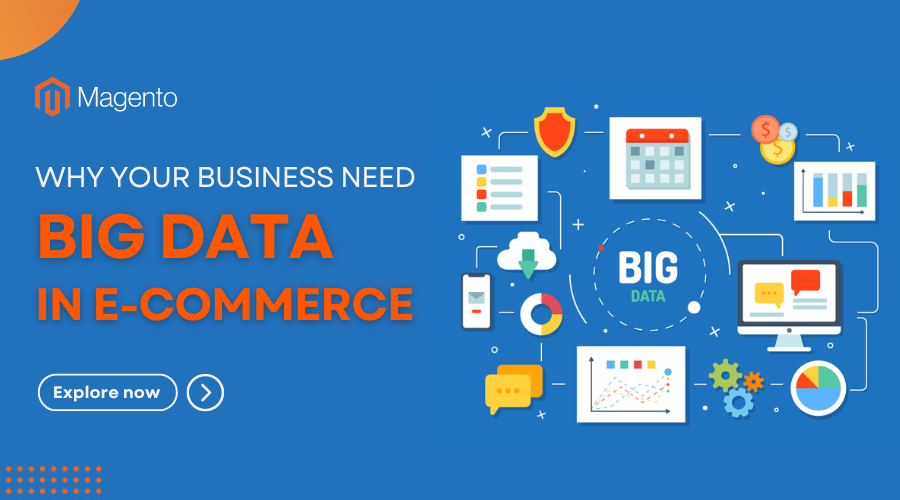
As eCommerce booms, big data eCommerce will be all about providing insight into how to improve it. To understand, online sales of goods have doubled in the last 4 years. Big Data in eCommerce provides improved customer experiences, optimizes inventories, and grows marketing. Let’s look closer at the key reasons why big data implementation is crucial to your retail business and how it answers common challenges.
Table of Contents
I. Big Data: The Changing Retail Challenges
In retail, ahead means being on-trend, and big data is a trend now. For instance, in 2015, Amazon had over 300 million active users; in September 2017, 183 million people visited the site. In comparison, Walmart and eBay had 87 million and 86 million visitors during the same period. PayPal, one of the most trusted payment systems, had 200 million active users worldwide in the third quarter of 2017.
According to this, big data is a game-changer because of its big promises and the reliable insights that drive better shopping experiences, smoothen operations, and improve marketing. This section has taken a look at how big data solves many important problems in retail and prepares you for future challenges.
1.1. Personalization and customer experience
Today’s consumers expect experiences that are just for them. Apps that use big data can provide such an experience. They make this possible since extensive customer data is analyzed to reveal buyer behaviors, preferences, and trends. This informs the retailer by:
- Offering personalized recommendations of the products.
- Sending personalized marketing messages
- Offering targeted promotions
Companies like Amazon and Netflix, which recognize the need to develop a shopping app, do a pretty good job of having personalized experiences, meaning loyal customers and possibly even stronger conversion rates.
1.2. Inventory management

Overall, good inventory management is one of the major techniques of cost reduction with the aim of maximizing sales. Big data helps retailers to:
- Forecast demand accurately
- Efficiently manage the levels of stock
- Avoid overstocking or stockouts
Predictive analytics tools monitor sales data, seasonal trends, and market conditions. Retailers like Walmart and Zara can respond to customer demand by keeping inventory levels right-tight.
II. Dynamic pricing with Big Data eCommerce

Dynamic pricing automatically adjusts the price of an item in real time by calculating demand, competition, and market conditions. Big data allows retailers to:
- Implement real-time pricing adjustments
Optimize pricing strategies for revenue and profits. The airlines and hotel chains use dynamic pricing, adjusting the rate according to demand, and that has shown how well such a strategy can succeed.
- Make patterns of engagement
With this information, retailers can come up with rather specific campaigns. They should analyze customer experience enhancement across a variety of channels and Build (improve) marketing more effectively for better ROI.
- Do fraud detection and prevention
Fraud is a major concern related to retail, both online and offline. Big data helps in the following way:
- Checking anomaly and unusual pattern detection
- Providing machine learning for real-time detection of suspicious transactions.
- Reducing financial losses due to fraud by strengthening fraud detection systems.
- Customer insights and behavior analysis
Understanding customer behavior is important for better growth and improved relationships. Big data provides:
- Insight into customer preference and buying behavior.
- Analysis of reviews and feedback
This enables retailers to rehash product offerings, marketing strategies, and customer service information. For example, sentiment analysis enables the display of customer satisfaction levels and helps revoke strategies that best suit them.
- Overcoming challenges in big data integration
While big data has enormous potential benefits, there are specific challenges in the integration of big data solutions into the current operations of retailers; it is in overcoming these that the full value of big data will be extracted. This section reviews major hurdles that retailers face in integrating big data solutions and various strategies to overcome such issues.
- Data quality and accuracy
Quality data is of paramount importance. For example, if Amazon’s data shows that a certain product is unavailable, but it actually is, there is a loss of sales. In order to avoid this, strong data governance is very important from the retailer’s perspective. Wal-Mart does this by automated cleaning and validating tools, which make sure that stock is actually reported and help improve supply chain efficiency.
- Integration into existing systems
This can sometimes get pretty complex, especially when integrating new big data solutions within an existing ecosystem. For example, even Target faced the issue of incompatibility and information silos when upgrading its analytics platform. To avoid these, retailers would have to choose scalable solutions and bridge the gap between systems and middleware. This can be further smoothened with the right collaboration from experts at IBM or SAP.
- Cost and resource allocation
Big data solutions may be very expensive. For example, Macy’s could face high expenses in deploying the new infrastructure of big data. Controlling cost: It is advisable that retailers try to estimate the returns on investment using AWS since it is highly scalable and has no upfront high costs.
- Privacy and security issues
With such a quantity of customer data, a growing concern about privacy and security arises. For instance, Best Buy has the difficult task of securing data from breaches while insisting that regulators adhere to regulations such as the General Data Protection Regulation. Moreover, encryption, access controls, and periodic security audits will make the data safe and in compliance with regulations.
- Skills and expertise
Extracting value from big data involves very specialized skills. It is very possible that Starbucks would not easily find such staff or train them in-house. For that reason, Starbucks invests in intensive training and partners with providers whose teams—like Microsoft Azure—can offer expert support and consulting.
III. Choosing the right Big Data solutions for eCommerce
The right big data solutions are going to add value to their benefits and help you integrate seamlessly with your eCommerce business. Now, let’s plunge into what you consider picking up the perfect tool and platforms for your retail needs.
3.1. Big data solution types

Big data solutions come in a myriad of shapes and sizes, each with special features. Choose among these:
- Data lake. A data lake is usually the ideal location to store large volumes of raw data in its native format.
- Data warehouses. It is very efficient for structured data and complicated queries, thus enabling deep analytics.
- Advanced analytics platforms. These platforms leverage machine learning and AI algorithms to process and analyze vast amounts of data and uncover hidden patterns and trends.
Based on the needs regarding data storage, processing power, and analytics tools, assess these options to choose a solution that would be in a position to cater to your business goals and technical requirements.
3.2. Scalability and flexibility
Your business will evolve, as will the demands around data. It will be important to select solutions that can adapt to the changing needs of your business. With scalable solutions, volumes of data growth and the addition of new data sources will be handled with ease, while flexible platforms allow for customization and appropriate integration with your existing systems. This way, big data tools will grow with your business.
3.3. Vendor selection criteria
Correct vendor selection is one of the important steps in this regard. Think about the seller’s reputation, support services, and overall cost. Customer testimonials, case studies, and service-level agreements can give a reasonable estimate of how reliable the support is. Similarly, discuss with them how their solutions will integrate with your systems to ensure seamless integration.
3.4. Implementation and training
First, planning—precisely defining timelines, resources, and milestones. Secondly, train your personnel for the effective use of the new tools. Take advantage of as much vendor training, online resources, and workshops as possible that you can conduct in-house for a seamless transition and bring maximum benefit out of your big data solution.
3.5. Measuring success
Clearly articulate the metrics and KPIs that will measure the effectiveness of your big data solution. Other key factors can be sales uplift, customer satisfaction, and efficiency. Periodically revisit this information, leveraging what you find to help drive revisions in your strategies to ensure the Big Data solution keeps adding value to your business goals.
Wrapping up
Big Data eCommerce can provide an edge to retailers. It helps improve customer experiences, smooths operations and helps make sharper strategic decisions. Mastery of big data could enable retailers to resolve some key challenges and realize new growth opportunities. The foundation of retailing in today’s fast-moving environment must be built on data usage. In other words, those retailers that move head-on toward embracing big data solutions and hence take on integration challenges will be better equipped to handle the shift toward a more data-driven marketplace.
Author bio
 | Yuliya Melnik is a technical writer at Cleveroad, a software development company that offers custom iOS app development services. She is passionate about innovative technologies that make the world a better place and loves creating content that evokes vivid emotions. |












![[SALE OFF] Discount 30% All Premium Extensions On Christmas And New Year 2025 christmas-and-new-year-2025](https://landofcoder.b-cdn.net/wp-content/uploads/2024/12/christmas-and-new-year-2025-1-218x150.png)






